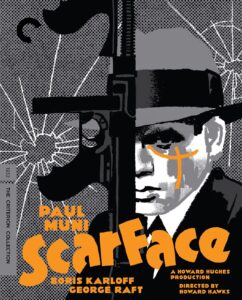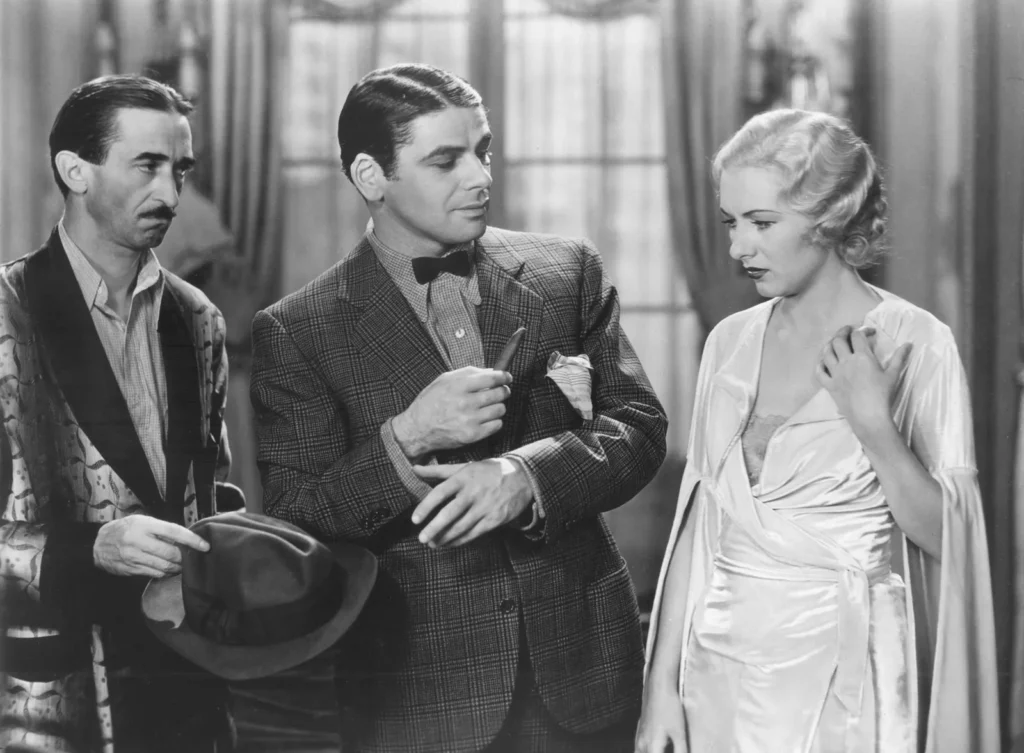Howard Hawks and Howard Hughes Present the GoodFellas of its day
DIRECTED BY HOWARD HAWKS/1932
STREET DATE: NOVEMBER 12, 2024/CRITERION COLLECTION

The Criterion Collection recently released the original Scarface from 1932 on 4K and Blu-ray. Many different masters of the classic Hollywood worked on it at the point in their professional lives when they got hold of their craft and began developing their voices in relative youth. It’s a film that reflects on the decade before it was made, told with a brash intention its artists were discovering in that moment.
Young and rebellious producer Howard Hughes put together two men who would push the new sound film into a more dynamic form. Howard Hawks had been directing for just six years with Scarface only being his third talkie. That talk and rapid plotting was supplied by four writers led by Ben Hecht a newspaper man-turned-play write-turned screenwriter who won the first original screenplay Oscar for one of the first gangster movies, Underworld. The combination of these two and other young artists helped create one of their most innovative and bold films, even compared to their latest more polished classics that would follow.
The plot works as a template for the gangster film. It opens with Tom Camonte, played by Paul Muni, rubbing out his boss to clear the way for the gang’s lieutenant, Johnny Lovo (Osgood Perkins). Lovo puts Tony in charge of their Southside bootlegging operation. Against Johnny’s wishes, Tony moves on the Irish mob, lead by the unseen O’Hara. When Tony conquers the north through violence, Lovo puts a hit on Tony. Tony survives and has his right hand, Guino (played by coin flipping George Raft), take him out. Tony puts himself on top with both the law and lawless after him for a fateful fall.

It’s what’s in between that plot that makes this standout from the other early mob classics like Little Caesar and The Public Enemy that mainly get their punch from their leads, Edward G. Robinson and James Cagney. There are scenes with Tony and his boys simply hanging out and having fun in their criminal life. The film contains a lot of black humor both from the characters and the film commenting on them. Hawks and Hecht treat the introduction of the tommy gun to prohibition warfare in a manner that treats Tony acts like a kid with a new toy. The two women are standouts. Lovo’s girlfriend Poppy (Karen Morley), who Tony wants, and Tony’s sister Cesca (Ann Dvorak) who he also may won’t. They are prototypes of the Hawksian women with their tough talk and own agency.
Style also plays a large part. This is one of Hawks most overtly stylish films. Lee Garmes, the cinematographer who had just worked with Josef von Sternberg on Shanghai Express, works in deep blacks and shadows that border on German expressionism. The heightened reality creates the look of tabloid photos in motion. Hawks and crew famously placed versions of Xs before or right after a murder in reference to how the papers would show where a body was discovered. Hecht and the other writers, many also former journos, tossed in slang filled dialogue and colorful but realistic characters like O’Hara enforcer Gaffney played by Boris Karloff who proves he can be chilling without monster makeup. The Criterion restoration brings out all of this smile with a crispness.

The 4K/Blu-ray’s extras are few but substantial. Imogen Sara Smith provides the print essay, delivering a smart overview of the movie. Actor and filmmaker Bill Hader and noir novelist and expert Megan Abbott have a lengthy and entertaining discussion about Scarface. The interaction of each person’s insight and sense of humor made me they could carve out some time for a podcast. Scholar Lea Jacobs educates us on Scarface’s use of editing and sound. Her comparison of it to Hawk’s previous movie, The Criminal Code is revelatory. Also included is the ending the censors forced on the original release, which Hawks had nothing to do with.
In viewing the Criterion version of Scarface, I couldn’t help but think of it as The Goodfellas of its day- another gangster picture directed by an innovator and written by a journalist. It quickly moves through its underworld life with colorful but deadly characters, often focused through the details of their life. It’s told in high style and gives the feeling to the viewer that everyone who worked on it at least once said, “What if we tried this?”. That makes for an exciting motion picture, no matter how old.

